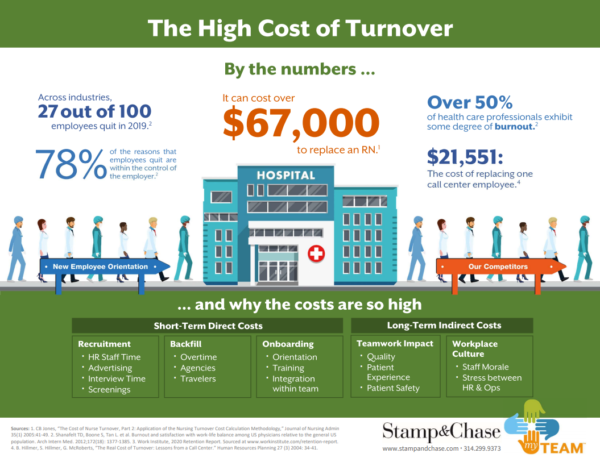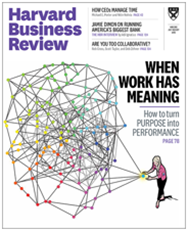LeaderBriefing
Serious about reducing employee turnover? Approach it as a leadership issue, not just an HR issue

Without question, healthcare employee turnover is one of the most far-reaching issues facing provider organizations today. The problem of not being able to retain staff impacts organizational success in multiple ways: patient experience, operational efficiency, meeting community needs, quality, and finance.
With the “great resignation” and changing labor force dynamics, most industries are losing workers at higher rates than in the past. But why is turnover so high in healthcare?
It is easy to write off higher turnover only to the stress of the pandemic, but the causes of employee turnover in healthcare are more complex. Research confirms that multiple aspects of the work environment itself, which can vary from department to department in the same organization, contribute to individuals wanting to leave or stay. Many of these same characteristics often are the root cause of burnout.

Perhaps ironically, the industry-wide recruitment strategies designed to help may in fact be contributing to the problem. Given aggressive recruiting by provider organizations and staffing agencies, even healthcare professionals who weren’t thinking about a job change are tempted to explore options.
What unintended messages is an aggressive recruitment strategy sending to current staff?
In the heat of battle to keep services adequately staffed, operational and HR executives understandably spend lots of time and money on hiring. If base compensation is aligned with major market competitors, many organizations turn to signing bonus and similar incentives as a differentiator to attract more candidates.
 Organizations often promote this strategy as supporting existing staff. “We know you’re exhausted, and we’re just trying to get you more help fast” is the frequent message. Leaders espouse similar reasons in their zeal to hire more agency or travel staff.
Organizations often promote this strategy as supporting existing staff. “We know you’re exhausted, and we’re just trying to get you more help fast” is the frequent message. Leaders espouse similar reasons in their zeal to hire more agency or travel staff.
But tired frontline professionals we talk with have one burning question: “What about our pay?!”
While well-intentioned and advancing a priority to take care of all patients at seemingly any cost, these aggressive recruitment strategies do little to recognize and reward loyalty.
Unfortunately, loyal staff in this environment are feeling anything but valued. More often, they feel taken advantage of, forgotten, and even foolish for staying while colleagues pursue better paying alternatives. At the extreme, they feel angry and disillusioned.

While hiring at any cost may appear to make sense in the short-term, it is not a sustainable strategy. As one health system executive we talked with put it, “We kept pouring more money into hiring but failed to notice that the recruitment budget bucket had a big hole in it: turnover.”
When staff are leaving more quickly than their replacements can be onboarded, organizations never catch up. This constant churn exhausts everyone: operational middle managers, human resources, and the frontline staff who have a constant parade of new colleagues to orient.
“Hemorrhaging” is the word we’re hearing most often to describe the staffing crisis in many healthcare provider organizations. And if that’s the problem, stopping the bleeding must be Job 1 for senior leadership. That starts with reducing turnover and the number of new hires organizations must find each month just to stay even.
The Power in Connections
Multiple issues affect any individual employee’s level of satisfaction in his/her job. But at the heart of the problem of turnover in healthcare is the extent to which a staff member feels a meaningful sense of connection to the organization, his/her manager, and customers/patients.
Connecting to Purpose
Understanding and leveraging purpose in organizations has emerged as one of the most talked about issues – and opportunities – in companies today. CEOs who are part of the prestigious Business Roundtable recently signed a new statement on the “Purpose of a Corporation.” No longer is simply driving shareholder value the top priority, they said. The statement recognized an organization’s role in serving all stakeholders: customers, employees, suppliers, communities and shareholders.
Many health care professionals would argue that the industry has always understood purpose. After all, isn’t serving our fellow human beings at some of the most vulnerable times in their lives the ultimate noble purpose? But recent research and insights into how purpose can and should be leveraged in organizations, especially among frontline staff, gives us important things to think about.
 “When Work Has Meaning” proclaimed the cover story of the July/August, 2018, issue of the Harvard Business Review. Like the profound statement from the Business Roundtable, this article turns long-standing business principles and theories on their head. Authors Anjan Thakor, the John E. Simon Professor of Finance at the Olin Business School at Washington University in St. Louis, and Robert E. Quinn, professor emeritus at the University of Michigan’s Ross School of Business and cofounder of the school’s Center for Positive Organizations, found that the traditional “principle-agent model” describing the economic relationship between a company and its employees precludes the notion of a fully engaged workforce.
“When Work Has Meaning” proclaimed the cover story of the July/August, 2018, issue of the Harvard Business Review. Like the profound statement from the Business Roundtable, this article turns long-standing business principles and theories on their head. Authors Anjan Thakor, the John E. Simon Professor of Finance at the Olin Business School at Washington University in St. Louis, and Robert E. Quinn, professor emeritus at the University of Michigan’s Ross School of Business and cofounder of the school’s Center for Positive Organizations, found that the traditional “principle-agent model” describing the economic relationship between a company and its employees precludes the notion of a fully engaged workforce.
“People who find meaning in their work don’t hoard their energy and dedication,” the authors emphasize. “They give them freely, defying conventional economic assumptions about self-interest. They do more – and they do it better.”
One of the authors’ most important and insightful messages is that the power of purpose doesn’t just naturally happen and influence the work environment in organizations, even when that underlying purpose is as mighty as it is in health care. Leveraging purpose must be intentional, authentic and central to how work gets done in the organization.
Connecting to Family
Leaders of some of the most successful, creative companies in the world, including Southwest Airlines, Chick-Fil-A and Costco, have referred to their organizations as a “family” when describing corporate culture and how they think about and support employees.
 In healthcare provider organizations, a supportive family culture may be even more powerful and appropriate. Is there another business where employees have the opportunity to become an extension of a customer’s family more than in healthcare? This is especially true in primary care long-term care, acute rehabilitation, home care and senior living.
In healthcare provider organizations, a supportive family culture may be even more powerful and appropriate. Is there another business where employees have the opportunity to become an extension of a customer’s family more than in healthcare? This is especially true in primary care long-term care, acute rehabilitation, home care and senior living.
If one of a leader’s most important jobs is modeling the behaviors and attitudes they expect their staff to exhibit toward customers, then supporting an employee team should take on some of the best aspects of “family,” including caring about one another beyond the strictly defined tasks of the job.
Connecting to Responsibility
Perhaps one of the most powerful connections that can be created between human beings is a sense of responsibility and commitment. The same idea is true for individuals and organizations. When employees feel valued and sincerely believe that their colleagues and patients are counting on them, they may think twice about leaving an organization. Of course, underlying this assumption is the employees’ confidence that the work they are doing truly is making a difference in the lives of others – and that it is appreciated.
Rethinking strategies and practices that encourage staff to stay — or stray
With these philosophic underpinnings that emphasize employees’ connection to the organization, leaders at all levels need to rethink specific strategies and practices that either encourage loyalty or – often inadvertently – contribute to resignation.
Compensation and Benefits Strategies
Pay strategies that prioritize recruitment of new employees over retention of existing staff can’t be flipped overnight. Even health systems that have said they will close beds to reduce agency expenses and overtime have struggled to implement this financially logical strategy. When push comes to shove, it is tough to turn away patients who need care – and the physicians who want to refer or admit them.
Rather, a thoughtful, structured transition from emphasizing outside recruitment to valuing loyalty must be effectively planned and communicated. While each organization and market will have unique challenges, there are common themes all providers should explore, such as:
- Leveraging current workforce capacity by creating ways for employees to accept open shifts across the organizations on their terms (Overtime is almost always less expensive than hiring travelers, and it encourages loyalty.)
- Setting realistic targets, strategies, and timeframes for ramping down agency and travel positions
- Treating travelers respectfully but differently from permanent staff, emphasizing that they are temporary visitors, not part of the family
- Post-COVID surge, insuring more predictability in schedules for hourly clinical staff
Incenting current staff to contribute to recruitment through more generous referral bonuses
Staff Recognition and Appreciation
Especially in large organizations, major operational or strategic initiatives often take on the characteristics of bureaucracies with rules, requirements, and restrictions. Simply, we’ve found that reward and recognition programs based on points and prizes just miss the mark.
In our years of working with organizations both large and small, dedicated frontline caregivers tell us that nothing means more than someone taking the time to look them in the eye, acknowledge something they’ve done, and sincerely say, “thank you.” Any staff recognition effort that is not based on this foundational practice risks cheapening expressions of gratitude and appreciation.
Investment in Employees’ Long-term Success
A very specific form of individual recognition is key to reducing turnover, especially for an organization’s “stars.” Dedicated team members need to know that leaders are interested in their personal and professional development.
While organization-wide tuition reimbursement or professional development workshops are appreciated, their impact on turnover pales in comparison to a leader sitting down with an employee to say, “I want to help you be successful, to grow, and to be more fulfilled in your job.”
Gallup calls these Stay Conversations. Others call them Re-recruitment Talks. We call them Development Dialogues.
 Regardless of what you call them, the distinguishing characteristic of these interactions is listening. Letting a staff member tell you what they need and then finding ways to individual their experience is key to convincing them to stay instead of stray.
Regardless of what you call them, the distinguishing characteristic of these interactions is listening. Letting a staff member tell you what they need and then finding ways to individual their experience is key to convincing them to stay instead of stray.
During the pandemic, we’ve recommended adapting the Development Dialogue to explore how the COVID crisis has affected them personally. As a starting point, here are the types of questions to consider:
- What has been most difficult for you recently?
- What accomplishment are you most proud of?
- What do you hope leadership really understands about what you’ve been through?
- How can your experience and skills contribute in an even bigger way to our team’s success?
- How can I and other members of the team best support you right now?
The idea of the Development Dialogue is to encourage richer, more meaningful conversations with individual employees. As a leader, your job is to open the door, not drag an employee through it. Individuals will accept the invitation in different ways depending on their own level of comfort and trust in their relationship with you.
Creating Community and Teamwork
In the Staff and Patient Experience Snapshot we conduct to assess organization culture, we often ask employees, “Why do you stay?” Invariably, “because of the people I work with,” is one of their top answers.
Frontline leaders often believe they alone must carry the burden for supporting each member of their team, especially during times of crisis. But one of the core characteristics of strong, resilient teams is support for one another.
 Rather than just thinking about how they personally can support each employee, exceptional leaders focus on ways to build teamwork so that colleagues help and encourage one another.
Rather than just thinking about how they personally can support each employee, exceptional leaders focus on ways to build teamwork so that colleagues help and encourage one another.
Synergistic teamwork that produces better, more sustainable results than individual effort can be nurtured in a number of straightforward ways:
- Regular, inclusive team meetings that encourage dialogue and meaningful discussion across the team
- Huddles at the beginning of each shift that encourage staff to work through problems and challenges together
- Effective work group leading goals that inspire teams to achieve success together
- Small but frequent performance improvement teams that promote group problem-solving
- Recognition of individual employees who provide support to their colleagues, which signals that the effort is appreciated and recognized by the leader
- Counseling for employees who fail to support their colleagues and who do not work well with others
Smart organizations and their leaders know that there is no silver bullet for reducing turnover. Ultimately, creating a workplace culture that encourages people to stay rather than stray requires a structured, consistent approach that clearly communicates one straightforward message to staff: you are critical to this organization’s success. We want and need you to stay.
